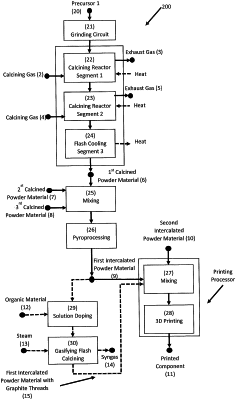| CPC H01M 4/0416 (2013.01) [H01M 4/0447 (2013.01); H01M 4/0459 (2013.01); H01M 4/133 (2013.01); H01M 4/1393 (2013.01); H01M 4/505 (2013.01); H01M 4/525 (2013.01)] | 11 Claims |

|
1. A process for producing a cathode or anode material adapted for use in the manufacture of fast rechargeable ion batteries comprising the steps of:
a. selecting a precursor material of a metal salt that, upon heating in a gas stream, creates porous materials to generate a material compound for an electrode in an ion battery;
b. grinding the precursor material to produce a powder of particles with a first predetermined particle size distribution between 0.2 to 100 microns to form a precursor powder;
c. calcining the precursor powder in a flash calciner reactor segment with a first process gas at a first temperature to produce a porous particle material for an electrode in an ion battery, and having the porosity in the range of 0.3-0.6, surface area in the range of 50 m2/g to 300 m2/g and nanoscale structures for applications in such batteries; wherein the first temperature is below 900° C. for a residence time of between about 10-30 seconds;
d. processing the porous particle material in a second calciner reactor segment with a second process gas to complete the calcination reaction, to anneal the calcined porous particle material to optimise the particle strength, and activating the calcined porous particle material in a battery cell such that the annealing modifies the oxidation state of the calcined porous particle material for increasing the charge density to form a second precursor powder; wherein an exhaust temperature of the second calciner reactor segment is 350° C. to 400° C. for a residence time of up to 40s or up to 650° C. for a residence time of about 3 seconds;
e. quenching the second precursor powder;
f. activating the particles of the quenched second precursor powder in an electrolytic cell by the initial charging steps to intercalate electrolyte ions in the particles.
|